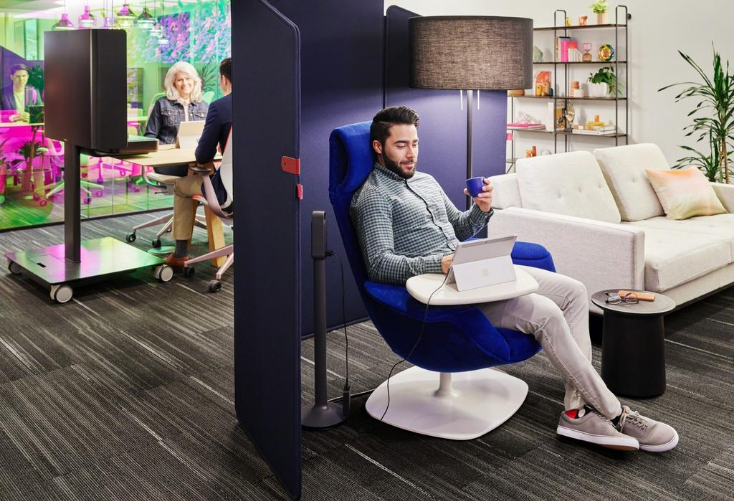- Amid the shifts in the landscape of work and workplaces, lessons from coworking are important for how and where work will happen moving forward.
- As people return to the workplace, choice will be one of the primary concerns.
- Coworking can teach organizations how to create meaningful work communities through intentional connections by catalyzing affiliation groups, organizing interest clubs or orchestrating moments for mindshare.
This article was originally published on Work Design Magazine.
The future of work is compelling. We are in the midst of the most significant reinvention of work in our experience. Everything is changing—not just in terms of where people work and when they work, but also in terms of the content and focus of work. Coworking is part of this reboot, and we can draw some powerful lessons from coworking models—lessons which provide compelling views for the future of work for all offices.
Choice Is Paramount
Coworking has taught us about the importance of choice, and it has been one of the drivers for people working from work clubs. As people return to the workplace, choice will be one of the primary concerns. Giving people options about when they return will be fundamental to their perceptions of safety and security. Employees have very different preferences for returning to the office. We know this from our customers and have also discovered this about our own employees. In our global survey, we found that people were split evenly between a desire to return to the office, a desire to continue working from home and a feeling of ambivalence about their return. Research demonstrates greater choice is correlated with greater engagement and giving people as much choice as possible matters especially now.
Coworking centers have long relied on data to ensure optimal utilization and to provide clear options for where people can work during any given day. This too is a relevant lesson. Moving forward, companies will need to communicate not only which spaces are available for people, but also which have been cleaned and are ready for use by the next occupant—the choices available. Giving people options and using data for an optimal employee experience are both opportunities to apply lessons from work clubs.
Community Drives Connection
Many people have chosen coworking because of the community offered through the experience. Work club community managers have brilliantly orchestrated opportunities for people to come together in pursuit of common interests, business development and rejuvenation. This is perhaps one of the most important lessons from coworking. The desire for connections with others is part of being human and people crave to be part of something—to feel a sense of camaraderie and unity. The pandemic has created stress and anxiety and much of this comes from being separated from others. According to one study, 75 percent of people reported a sense of social isolation and their sense of loneliness was greater if they had been working from home for a longer period of time.

The office provides for connection.
Companies can have significant positive impact by creating the conditions for people to come together in spaces that are both safe and compelling—whether it’s through a work café in which people can have a (socially distanced) chat or an ancillary space in which the openness provides for safer levels of both airflow and idea flow. They can also learn from the coworking model by making connections intentional—through catalyzing affiliation groups, organizing interest clubs or orchestrating moments for mindshare. Work is fundamentally social, so community, connections and camaraderie are priorities for the most effective employee experience.
Innovation Is Inspired
Another lesson from coworking centers is the boundary spanning and innovation which are fundamental to the experience. We know many people have chosen to work at coworking centers because they have more contact with people outside their traditional network. Great ideas typically come from the edges—from those not already mired in the traditional expertise of a function. In addition, new innovations arise from joining disparate ideas together in new ways. All of this is catalyzed by coworking and is something from which companies can learn. In fact, coming together at an office is one of the best ways to foster creativity and ideation. It’s one of the elements both companies and employees had been missing when stay-at-home orders forced everyone to work away from the office. Running into colleagues from different departments or the ability to more easily develop ideas with a cross section of people across the organization all make the office ripe for generating ideas. Applying lessons from coworking, we know that while working from home is likely here to stay, the office too must be part of the future—to catalyze creativity and inspire innovation that happens face-to-face and isn’t limited by a slow internet connection or (seemingly) ever-present technology trouble.
Experience is Everything

The office provides inspiration.
Recently, a friend of mine was hired away from a global hospitality company to take the lead in real estate and facilities for another major brand. They recruited him because they knew a gracious experience would be paramount to their success with attraction, retention, engagement and development of talent. Coworking has taught us this lesson as well. In a work club, the experience is the differentiator. We’ve always talked about the office needing to be a magnet for talent, but as we get back to the workplace following stay-at-home orders, we can learn from coworking. Creating a great experience, designing a place that competes with the richness of other environments and fashioning an office that provides an ecosystem of spaces will all be critical to success of businesses through and beyond the pandemic.
Wellbeing Is Enhanced
Another lesson from the coworking experience is its contribution to wellbeing. Exclusively working from home can be exhausting and getting out of a home office provides a healthy sense of routine and also a constructive boundary between home and work. An office location can provide for more movement through the day which is correlated not only with better physical health, but also with better memory and learning as well. We’re hearing a number of companies are planning to retain hub or headquarter locations for critical collaboration and co-creation. But they also plan to expand their number of spoke locations—places people can go to focus and work away from home, which won’t require the same commute (also positively affecting the environment). This compromise—in ensuring connectivity through the office and also embracing places closer to homes—aptly applies lessons from coworking.
Amid seismic shifts in the landscape of work and workplaces, coworking provides important lessons for how and where work will happen moving forward. Choice, community, innovation, experience and wellbeing are important places to start in terms of how we apply lessons from the coworking experience.


 Dr. Gleb Tsipursky – The Office Whisperer
Dr. Gleb Tsipursky – The Office Whisperer Nirit Cohen – WorkFutures
Nirit Cohen – WorkFutures Angela Howard – Culture Expert
Angela Howard – Culture Expert Drew Jones – Design & Innovation
Drew Jones – Design & Innovation Jonathan Price – CRE & Flex Expert
Jonathan Price – CRE & Flex Expert












